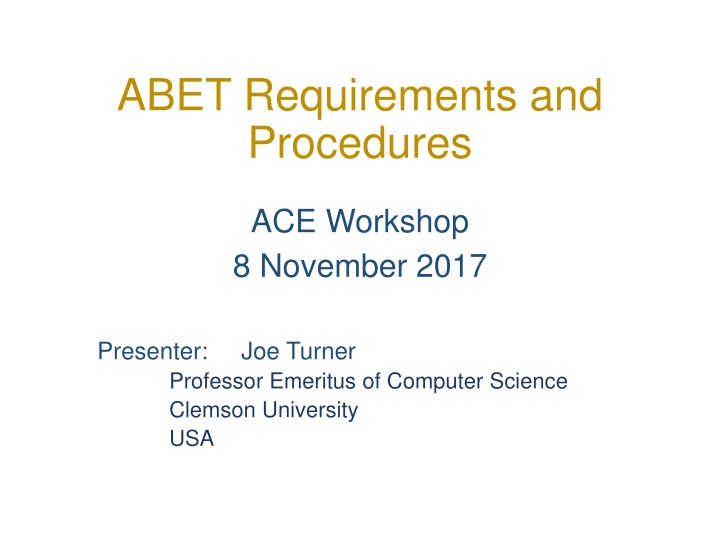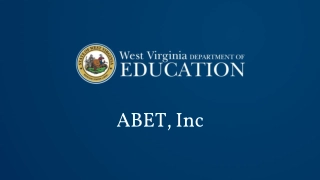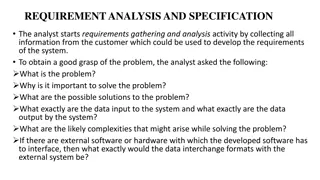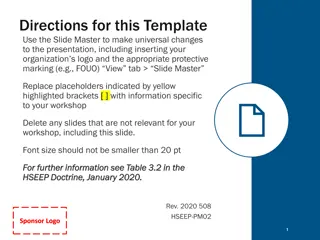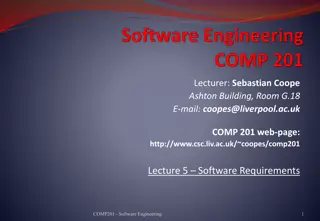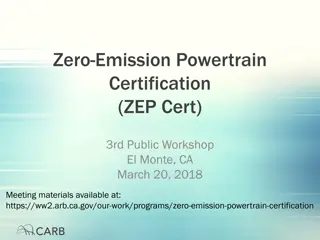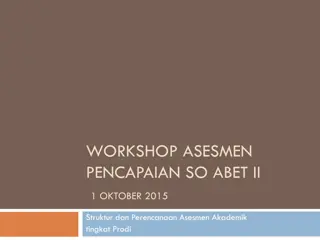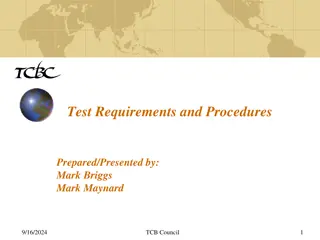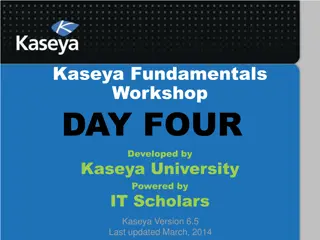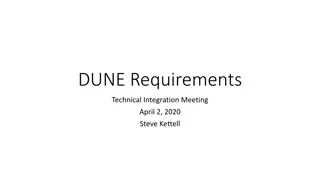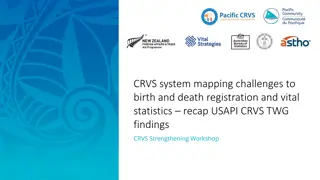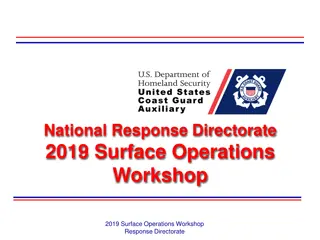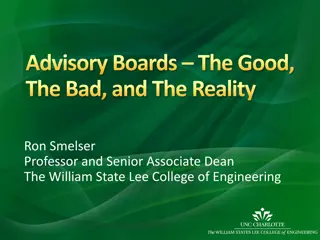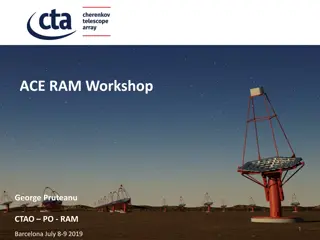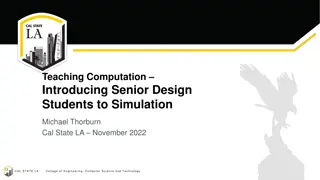ABET Requirements and Procedures Workshop
In this workshop led by Professor Joe Turner, participants will gain insights into ABET accreditation requirements, procedures, and international options for STEM programs. The session covers key topics such as ABET criteria, policies, accreditation process, and more. Definitions related to courses, programs, and student outcomes will also be explained to enhance understanding. Don't miss out on this valuable opportunity to explore the world of accreditation in computing and engineering.
Download Presentation

Please find below an Image/Link to download the presentation.
The content on the website is provided AS IS for your information and personal use only. It may not be sold, licensed, or shared on other websites without obtaining consent from the author.If you encounter any issues during the download, it is possible that the publisher has removed the file from their server.
You are allowed to download the files provided on this website for personal or commercial use, subject to the condition that they are used lawfully. All files are the property of their respective owners.
The content on the website is provided AS IS for your information and personal use only. It may not be sold, licensed, or shared on other websites without obtaining consent from the author.
E N D
Presentation Transcript
ABET Requirements and Procedures ACE Workshop 8 November 2017 Presenter: Joe Turner Professor Emeritus of Computer Science Clemson University USA
Who am I? (1) Retired Professor of Computer Science, Clemson University Former Professor and Dean of Information Systems, Zayed University (UAE) Over 30 years of experience in computing and engineering accreditation with ABET and CSAB Multiple officer/leadership positions Chair of more than 30 evaluation teams, member of 4 more ACE Workshop 8 November 2017 2
Who am I? (2) Initial Chair of Seoul Accord, an international mutual recognition accord among accreditors for computing programs. Substantial consulting experience in preparation for ABET accreditation Chaired a team of consultants that reviewed some engineering programs at three ACEs relative to preparation for possible ABET accreditation. ACE Workshop 8 November 2017 3
Intended outcomes for this session Participants will have a basic understanding of the requirements to obtain accreditation by ABET. Participants will have a basic understanding of the ABET accreditation process and what is needed to prepare for an ABET review. Participants will be introduced to options for international accreditation of STEM programs. ACE Workshop 8 November 2017 4
Some definitions In this presentation, the following definitions apply: Course: A collection of student learning activities that takes place during a semester or other term. Program: A collection of course requirements that leads to granting of a degree or certification by an educational institution. Student outcomes: What students are expected to know and be able to do at the time of graduation from a program. ACE Workshop 8 November 2017 5
Session outline 1. What is ABET? 2. ABET Criteria for Accreditation 3. ABET Policies and Procedures (APPM) Requirements 4. ABET Accreditation Process 5. International Accreditation for Computing and Engineering Programs 6. Final Notes ACE Workshop 8 November 2017 6
Session outline 1. What is ABET? 2. ABET Criteria for Accreditation 3. ABET Policies and Procedures (APPM) Requirements 4. ABET Accreditation Process 5. International Accreditation for Computing and Engineering Programs 6. Final Notes ACE Workshop 8 November 2017 7
What is ABET? (1) ABET is a US-based organization that Is non-governmental and non-profit. Accredits tertiary-level (university) programs in Applied and natural science Computing Engineering Engineering technology Does not accredit departments, colleges, or other administrative units. ACE Workshop 8 November 2017 8
What is ABET? (2) Has been accrediting engineering programs since 1932 Currently accredits 3,852 programs at over 776 colleges and universities in 31 countries 677 programs (18%) at 122 colleges and universities (16%) in 30 countries outside the US Web site: www.abet.org ACE Workshop 8 November 2017 9
ABET accreditation (1) ABET baccalaureate-level accreditation in STEM programs is intended to recognize programs that adequately prepare graduates for entry into relevant professional practice. A decision to seek ABET accreditation is voluntary. ABET makes no inference about the adequacy of programs that do not seek accreditation. ACE Workshop 8 November 2017 10
ABET accreditation (2) ABET accreditation is based on a set of standards (criteria) that programs must satisfy in order to be accredited. There are non-US engineering and computing accrediting organizations that have different sets of standards for accreditation. ABET recognizes the programs accredited by some of these other organizations as also producing graduates who are prepared for entry to professional practice. ACE Workshop 8 November 2017 11
ABET Commissions The four commissions of ABET carry out the accreditation processes: Applied and Natural Science Accreditation Commission (ANSAC) Bachelor, Master, 2-year Computing Accreditation Commission (CAC) Bachelor only Engineering Accreditation Commission (EAC) Bachelor, Master Engineering Technology Accreditation Commission (ETAC) Bachelor, 2-year, 3-year ACE Workshop 8 November 2017 12
ABET commission determination The name (title) of a program determines the commission that must review and make an accreditation decision for the program. Examples: Computer science: CAC Computer engineering: EAC Computer engineering technology: ETAC Industrial Hygiene: ANSAC Information Systems Engineering: CAC and EAC ACE Workshop 8 November 2017 13
ABET volunteers All ABET Directors, Commissioners, and review team members are volunteers. They serve without compensation of any kind in service to education and the profession. They are only reimbursed for actual expenses in conducting ABET activities. More than 2000 volunteers contribute to ABET activities. ACE Workshop 8 November 2017 14
Session outline 1. What is ABET? 2. ABET Criteria for Accreditation 3. ABET Policies and Procedures (APPM) Requirements 4. ABET Accreditation Process 5. International Accreditation for Computing and Engineering Programs 6. Final Notes ACE Workshop 8 November 2017 15
Basis for determining whether a program is accredited Primary: ABET Criteria for program accreditation. Also: ABET Accreditation Policies and Procedures Manual (APPM) Qualification requirements for accreditation consideration. Administrative procedures and requirements. ACE Workshop 8 November 2017 16
Requirement for accreditation A program can be accredited only if every applicable criterion and policy is satisfied. That is: If any applicable criterion or policy is not met, then the program cannot be accredited. ACE Workshop 8 November 2017 17
ABET criteria documents There is one criteria document for each commission: ANSAC: Criteria for Accrediting Natural and Applied Science Programs CAC: Criteria for Accrediting Computing Programs EAC: Criteria for Accrediting Engineering Programs ETAC: Criteria for Accrediting Engineering Technology Programs ACE Workshop 8 November 2017 18
Structure of criteria The structure of the undergraduate (bachelor s) criteria for each commission is the same: General Criteria: Criteria that apply to every program accredited by the commission. Program Criteria: Additional criteria that apply to specific program names. ACE Workshop 8 November 2017 19
General Criteria Same for all commissions: 1. Students 2. Program Educational Objectives 3. Student Outcomes 4. Continuous Improvement 5. Curriculum 6. Faculty 7. Facilities 8. Institutional Support ACE Workshop 8 November 2017 20
Program Criteria Additional criteria requirements for individual programs, determined by the name (title) of the program ACE Workshop 8 November 2017 21
General Criteria details In this section the details for each General Criterion are discussed. The criteria are the same for all commissions except: Criteria 3 (Student Outcomes), 5 (Curriculum), 6 (Faculty) ACE Workshop 8 November 2017 22
Criterion 1. Students Criterion statement (part 1): Student performance must be evaluated. Student progress must be monitored to foster success in attaining student outcomes, thereby enabling graduates to attain program educational objectives. Students must be advised regarding curriculum and career matters. ACE Workshop 8 November 2017 23
Criterion 1. Students (continued) Criterion statement (remainder): The program must have and enforce policies for accepting both new and transfer students, awarding appropriate academic credit for courses taken at other institutions, and awarding appropriate academic credit for work in lieu of courses taken at the institution. The program must have and enforce procedures to ensure and document that students who graduate meet all graduation requirements. ACE Workshop 8 November 2017 24
Criterion 2. Program Educational Objectives Definition: Program educational objectives are broad statements that describe what graduates are expected to attain within a few years of graduation. Note: PEOs are the expected professional accomplishments of graduates a few years after beginning their careers. Example: Graduates will be successful in designing solutions for complex computing projects. ACE Workshop 8 November 2017 25
Criterion 2. Program Educational Objectives (1) Criterion statement (part 1): The program must have published program educational objectives that are consistent with the mission of the institution, the needs of the program s various constituencies, and these criteria. ACE Workshop 8 November 2017 26
Criterion 2. Program Educational Objectives (2) Criterion statement (remainder): There must be a documented, systematically utilized, and effective process, involving program constituencies, for the periodic review of these program educational objectives that ensures they remain consistent with the institutional mission, the program s constituents needs, and these criteria. ACE Workshop 8 November 2017 27
Criterion 3. Student Outcomes Definition: Student outcomes are descriptions of what students are expected to know and be able to do by the time of graduation. Example: Graduating students will have an ability to identify, formulate, and solve complex computing problems. Note: Criterion 3 is different for each commission. Criterion 3 for the EAC is shown here. ACE Workshop 8 November 2017 28
Criterion 3. Student Outcomes (EAC) The program must have documented student outcomes that support the program educational objectives. Attainment of these outcomes prepares graduates to enter the professional practice of engineering. Student outcomes are outcomes (1) through (7), plus any additional outcomes that may be articulated by the program. 1. an ability to identify, formulate, and solve complex engineering problems by applying principles of engineering, science, and mathematics ACE Workshop 8 November 2017 29
Criterion 3. Student Outcomes (EAC) 2. an ability to apply engineering design to produce solutions that meet specified needs with consideration of public health, safety, and welfare, as well as global, cultural, social, environmental, and economic factors 3. an ability to communicate effectively with a range of audiences 4. an ability to recognize ethical and professional responsibilities in engineering situations and make informed judgments, which must consider the impact of engineering solutions in global, economic, environmental, and societal contexts ACE Workshop 8 November 2017 30
Criterion 3. Student Outcomes (EAC) 5. an ability to function effectively on a team whose members together provide leadership, create a collaborative and inclusive environment, establish goals, plan tasks, and meet objectives 6. an ability to develop and conduct appropriate experimentation, analyze and interpret data, and use engineering judgment to draw conclusions 7. an ability to acquire and apply new knowledge as needed, using appropriate learning strategies. ACE Workshop 8 November 2017 31
Criterion 4. Continuous Improvement Note: The student outcomes in this criterion refer to all student outcomes defined in accordance with Criterion 3. ACE Workshop 8 November 2017 32
Criterion 4. Continuous Improvement Definitions: Assessment refers to processes for identifying and collecting data to evaluate the attainment of student outcomes. Evaluation refers to processes for interpreting the data obtained through assessment processes. ACE Workshop 8 November 2017 33
Criterion 4. Continuous Improvement Criterion statement (part 1): The program must regularly use appropriate, documented processes for assessing and evaluating the extent to which the student outcomes are being attained. ACE Workshop 8 November 2017 34
Criterion 4. Continuous Improvement Criterion statement (remainder): The results of these evaluations must be systematically utilized as input for the continuous improvement of the program. Other available information may also be used to assist in the continuous improvement of the program. ACE Workshop 8 November 2017 35
Continuous Improvement Processes Cycle 36 For each student outcome: Evaluate assessment data Identify sources of assessment data Collect assessment data Action needed ? No Determine action needed Implement action Yes
37 Continuous Improvement Notes Details on ways to implement good continuous improvement processes require far more time than is available today. ABET provides multi-day workshops on implementing good continuous improvement processes. It is difficult to implement good processes without knowledgeable help.
38 Criterion 5. Curriculum Note: Criterion 5 is different for each commission. Criterion 5 for engineering programs is shown here.
39 Criterion 5. Curriculum EAC criterion statement (part 1): The curriculum requirements specify subject areas appropriate to engineering but do not prescribe specific courses. The program curriculum must provide adequate content for each area, consistent with the student outcomes and program educational objectives, to ensure that students are prepared to enter the practice of engineering. The curriculum must include:
Criterion 5. Curriculum EAC criterion statement (part 2): (a) a minimum of 30 semester credit hours (or equivalent) of a combination of college-level mathematics and basic sciences with experimental experience appropriate to the program. (b) a minimum of 45 semester credit hours (or equivalent) of engineering topics appropriate to the program, consisting of engineering and computer sciences and engineering design, and utilizing modern engineering tools. ACE Workshop 8 November 2017 40
Criterion 5. Curriculum EAC criterion statement (remainder): c) a broad education component that complements the technical content of the curriculum and is consistent with the program educational objectives. d) a culminating major engineering design experience that 1) incorporates appropriate engineering standards and multiple constraints, and 2) is based on the knowledge and skills acquired in earlier course work. ACE Workshop 8 November 2017 41
Criterion 5. Curriculum Notes: 1. The EAC major design experience is a major project, normally spread over the two semesters of the final year. 2. The EAC major design experience must be required of all engineering students and is a very important consideration in an evaluation of the program for accreditation. ACE Workshop 8 November 2017 42
Criterion 5. Curriculum Notes: 3. The various program criteria normally specify additional curriculum requirements for specific program names. ACE Workshop 8 November 2017 43
Criterion 6. Faculty There are some variations in the Faculty Criterion for each commission, but all are similar. The Faculty Criterion for the Engineering Accreditation Commission is shown here. ACE Workshop 8 November 2017 44
Criterion 6. Faculty EAC criterion statement (first sentence): The faculty must be of sufficient number and must have the competencies to cover all of the curricular areas of the program. ACE Workshop 8 November 2017 45
Criterion 6. Faculty EAC criterion statement (second sentence): There must be sufficient faculty to accommodate adequate levels of student- faculty interaction, student advising and counseling, university service activities, professional development, and interactions with industrial and professional practitioners, as well as employers of students. ACE Workshop 8 November 2017 46
Criterion 6. Faculty EAC criterion statement (third sentence): The program faculty must have appropriate qualifications and must have and demonstrate sufficient authority to ensure the proper guidance of the program and to develop and implement processes for the evaluation, assessment, and continuing improvement of the program, its educational objectives and outcomes. ACE Workshop 8 November 2017 47
Criterion 6. Faculty EAC criterion statement (last sentence): The overall competence of the faculty may be judged by such factors as education, diversity of backgrounds, engineering experience, teaching effectiveness and experience, ability to communicate, enthusiasm for developing more effective programs, level of scholarship, participation in professional societies, and licensure as Professional Engineers. ACE Workshop 8 November 2017 48
Criterion 7. Facilities Criterion statement (first sentence): Classrooms, offices, laboratories, and associated equipment must be adequate to support attainment of the student outcomes and to provide an atmosphere conducive to learning. ACE Workshop 8 November 2017 49
Criterion 7. Facilities Criterion statement (second sentence): Modern tools, equipment, computing resources, and laboratories appropriate to the program must be available, accessible, and systematically maintained and upgraded to enable students to attain the student outcomes and to support program needs. ACE Workshop 8 November 2017 50
